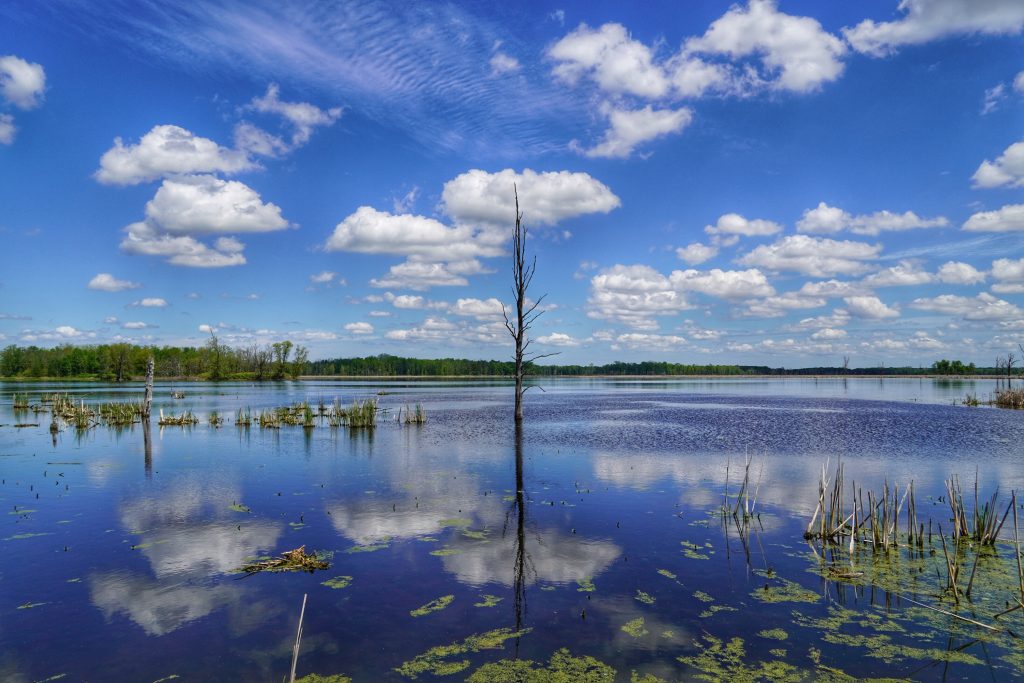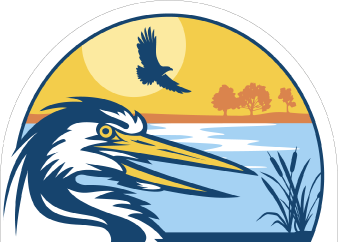
People who visit the Iroquois National Wildlife Refuge very often describe it as a well-kept secret, a gem of conservation. But it isn’t a park or recreation area. Neither is it a preserve or sanctuary.
It is a National Wildlife Refuge – and much of it is closed to the public for much of the year.
Click here to become a member!
Click here to donate!
So, when you visit the refuge these days, you will see a short notice posted. That notice reads, in pertinent part:
We would like to remind all our visitors that this is a critical time for migratory birds that are traveling hundreds or even thousands of miles to their breeding areas.
To help reduce disturbance for our migrants, or those setting up nesting areas, most of the refuge is closed to the public from March 1 through September 30.
For those wanting to enjoy a nature hike or observe wildlife from their vehicles, the refuge trails and overlooks remain open.
So why is that? And what exactly is a wildlife refuge, anyway?
The National Wildlife Refuge System is a network of public lands created by Congressional action that are dedicated to conservation. In forming the system, Congress was responding to pressure from many divergent groups to protect the natural heritage of the country from unchecked exploitation. Throughout the long and sometimes complicated evolution of the National Wildlife Refuge System, conservation was always the overarching mission of these lands. The United States Fish & Wildlife Service home page (https://www.fws.gov/refuges/about/) explains:
- The mission of the National Wildlife Refuge System is to administer a national network of lands and waters for the conservation, management and, where appropriate, restoration of the fish, wildlife and plant resources and their habitats within the United States for the benefit of present and future generations of Americans.
- [The National Wildlife Refuge System] protects some of the country’s most iconic ecosystems and the fish and wildlife that rely on them … . The Refuge System also conserves waterways that give life to all of them – critical ecosystems along rivers, streams, wetlands, coasts and marine areas.
- Wildlife conservation drives everything on national wildlife refuges, from the purposes for which each refuge was established, to the recreational activities offered, to the resource management tools used. …
Each refuge is established to serve a statutory purpose that, with a few exceptions, targets the conservation of native species dependent on its lands and waters. All activities on these acres are reviewed for compatibility with this statutory purpose.
The National Wildlife Refuge System has a complex history, and multiple Congressional statutes were part of the System’s evolution from the beginning of the 20th Century until today. Of the many statutes that contributed to its development, three stand out as being the foundation for the National Wildlife Refuge System as it currently exists: The Migratory Bird Conservation Act of 1929, authorized the purchase or rental of lands suitable “…for use as an inviolate sanctuary, or any other management purposes, for migratory birds”. Iroquois’ establishment in 1958 was under this authority. Congress eventually formalized the National Wildlife Refuge System in 1966 under the National Wildlife Refuge System Administration Act, which was the first statute to treat the various Federally established wildlife refuges as a comprehensive system. In 1997, Congress amended the 1966 act with the National Wildlife Refuge System Improvement Act. This Act does several things. First, it provides a clear mission for the refuges. Second, it identifies wildlife-dependent recreational uses that will be given priority consideration. These include hunting, recreational fishing, wildlife observation, wildlife photography, environmental education, and interpretation. Any use, though, must not interfere with the refuge’s purpose or public safety. Refuge managers have discretion to suspend or cancel these uses if they find they are interfering with the conservation mission. Finally, the 1997 Act also clarifies the process for determining the compatibility of refuge uses and mandates a long-term refuge planning process, including comprehensive conservation plans, for all refuges. For further reading, a historical time line of pertinent legislation is available at https://www.fws.gov/refuges/history/historical-timeline.html, and a short discussion of the National Wildlife Refuge System Improvement Act is available at https://www.fws.gov/refuges/policiesandbudget/hr1420_index.html
Over the last century, the National Wildlife Refuges have been a real conservation success story, and Iroquois is no exception. Iroquois completed its comprehensive conservation plan in 2011, to be reviewed and reissued in 2025. The plan is available at https://www.fws.gov/refuge/Iroquois/what_we_do/finalccp.html. For the patient watcher, Iroquois is a marvelous place to observe wildlife engaging in daily routines free of interference; for the hunter and fisherman, it’s an opportunity to enjoy those pursuits in natural surroundings. It’s widely touted as a paradise for birders: the Iroquois Observations Facebook Group features daily professional-grade photographs taken by dedicated photographers and bird watchers that showcase the diversity and richness of the habitats here. Also, Iroquois is special in that it has substantial state wildlife management lands on either side of it. Combined, these tracts comprise almost 19,000 acres, the largest contiguous conservation area in Western New York and one of the most productive in the Eastern United States.
We, as the visitors who benefit from the refuge’s conservation successes, have our part to play as well. It is public land, but we share in the responsibility for keeping it and advancing its purpose. We can do that if we follow some simple rules:
Stay on the trails. Granted, there are large areas of any wildlife refuge that are restricted from public access over much of the year. There’s a good reason for that. Areas that are marked as being restricted are so marked to allow for breeding, feeding, and sheltering of the plants and animals that make their homes here. Allowing unrestricted access would disturb one or more of these functions, and might well drive some of these species away. Typically, wildlife refuges have trails and overlooks from which one can observe and enjoy the land and its wildlife, and Iroquois has some of the best in Western New York.
Pack out our trash. Basic hiking etiquette requires that we ‘carry in, carry out’ so that we ‘leave no trace.’ One presumes that visitors would employ this practice as a courtesy to the staff and to other visitors, but that doesn’t always happen. Aside from that, however, there are also some very strong practical reasons for picking up after ourselves: Cans, bottles, and sixpack holders can be traps; waste oil, antifreeze, suntan lotion, and other chemical products can poison the residents; cigarette butts, leftover picnic scraps, used baby diapers, plastic wrappers, and other trash can injure, sicken, or otherwise degrade both the habitat and creatures in it; some foods that are perfectly fine for us can be deadly to other creatures, and even if not, would train these creatures that humans are a food source. What makes Iroquois such a magical place is mostly the undisturbed habitats that exist here, and the richness of the ecosystems that use them. So, remember – every litter bit hurts! When you hike the trails, practice ‘carry in, carry out’. Subsequent visitors will appreciate the courtesy.
Police our pets. Pets are not part of the natural community. Dogs enjoy the refuge as we do – a new place, full of wonderful creatures and exciting smells – and given the opportunity, will explore the trail and areas around the trail very enthusiastically, scaring up and chasing any of the local residents who happen to be in the way. Indeed, an experienced tracker can tell very quickly which is the fox or coyote and which is the family retriever. And unless we clean up after them, they will create a mess on the trails which detracts from the experience other visitors have – if the primary thing the kindergarten class remembers is the dog poop on the trails, that doesn’t contribute to the conservation mission. So when walking the trails, please keep your pet on a leash, and clean up after it.
Observe all trail restrictions. The refuge imposes some specific restrictions on some of our trails and activities to prevent their use from becoming a nuisance and interfering in the conservation mission. For example:
- The Mohawk Ski Trail, a seven mile trek through several discrete habitats around the Mohawk pool, is only open during the winter season when there’s snow on the ground – during other seasons, the plant and animal communities along the trail are much more active. Deer often hide their fawns in the grass and brush lands, birds nest in the wooded areas adjacent to them, marshes are home to various waterfowl. All of that would be subject to continual disruption if the refuge were to permit hiking along that trail during the off season.
- Bicycling. For all but one of our trails, the refuge does not allow bicycling or other vehicular traffic, motorized or not. Any vehicle traffic will disturb wildlife living or feeding along the trail, and in time will degrade the trail itself – most are not suitable for bicycling: the land is soft and marshy much of the year, and vehicles of any sort would tear the paths up. Feeder Road has a roadbed that is suitable for bicycling and as such, bicycling is allowed on that trail from Rte 77 to Dunlop Road.
- Water trails. Parts of Oak Orchard Creek are open to canoeing and kayaking, but west of Rte 63, the refuge prohibits boat traffic. This is to provide an undisturbed habitat for the waterfowl and other creatures that make up the marsh and wetlands communities.
- Special Use Permits. There are several recreational uses that require prior coordination with the refuge staff. These include trapping, handicapped-accessible hunting, off-trail photography, and educational programs. Proposals must be submitted by the applicant and must be reviewed and approved by refuge staff prior to the activity actually taking place. As with any other use, these special uses must be consistent with the refuge’s purpose, and are subject to suspension or cancellation by the refuge manager.
None of this is to suggest that the refuge is completely off-limits, as a preserve or sanctuary might be. The conservation mission includes recreational and educational uses, so walk the trails, watch and listen for the residents, and increase your knowledge and enjoyment of the fish and wildlife and their habitats. But help out the staff and the volunteers there, and help protect the refuge’s wildlife.
Please leave no trace, keep your dog on a leash, and be sure you know where you may go and when you may go there.


